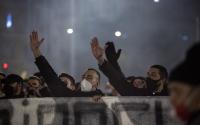Common Dreams / Published on Saturday, May 10, 2003 by the Los Angeles Timesby Paul Richter
The Bush administration took a big step toward developing a new generation of nuclear weapons Friday when a Senate panel approved a bill that would lift a 10-year ban on researching small atomic bombs for battlefield use and fund more study on a nuclear "bunker-buster" bomb.
The annual defense authorization bill, approved by the Senate Armed Services Committee, would also increase funding for a nuclear weapons site in Nevada to enable the Pentagon — if necessary — to more quickly resume the weapons testing it suspended 11 years ago.
The administration, in a major shift of recent U.S. nuclear weapons doctrine, has been moving to develop options with nuclear weapons to enable it to better deal with emerging threats, such as the deeply buried bunkers where potential adversaries may conceal banned weapons and missiles.
Administration officials have been formulating a new policy since President Bush came into office but are only now beginning to carry out the changes.
Since the end of the Cold War, the United States has not designed any new nuclear weapons, as it and Russia have worked to scale back their strategic nuclear arsenals.
The administration's new tack has alarmed arms control advocates, who fear that the availability of smaller bombs that promise less secondary damage would encourage nations to use weapons that have been nearly unthinkable for half a century.
They worry that expansion of the U.S. nuclear arsenal would encourage more countries to build weapons and weaken already fragile international nonproliferation efforts.
"We're moving away from more than five decades of efforts to delegitimize the use of nuclear weapons," said Sen. Jack Reed (D-R.I.), a member of the Senate Armed Services Committee.
He questioned whether the United States needs additional nuclear weapons, especially given the growing capabilities of its conventional precision-guided munitions.
The administration's logic, Reed said, is that "we don't want to be constrained in any way about any weapon we want to field."
The defense authorization bill will be considered on the floor of the Senate and House this month, and some senators have promised to challenge one or more of the nuclear provisions at that time.
But several congressional strategists said the critics' best shot at stopping the nuclear weapons provisions was in the Senate committee deliberations, and they predicted that the language will be adopted as written.
When critics sought during Thursday's committee deliberations to strike the language lifting the ban, they were unable to prevent some of the 12 Democratic members from joining the 13-member Republican majority in approving it.
The bill would provide $15.5 million in funding for research on a large hydrogen bunker-buster bomb called the Robust Nuclear Earth Penetrator.
This bomb would be a redesigned version of an existing nuclear weapon to make it better able to burrow deeply into the earth.
Unlike the proposed low-yield bombs, which have an explosive force of no more than 5 kilotons — five thousand tons of TNT — this weapon would have yields in the range of tens of kilotons, to a megaton, making it at least six times more powerful than the bomb that was dropped on Hiroshima, Japan.
It would be intended to generate shock waves that could crush targets 300 meters below the earth, experts say. Critics contend the fallout would cover such a wide area and cause so many casualties that presidents would be reluctant to order its use.
Along with the $15 million for research on the bunker buster, the bill would set aside $6 million for advanced research on nuclear weapons.
The bill also seeks $25 million in improvements to the Nevada nuclear weapons test site and U.S. nuclear labs because U.S. officials fear some of the nuclear infrastructure has become unreliable since President Clinton declared a voluntary test moratorium.
Clinton ordered that the nuclear weapons complex should be prepared to restart testing within two to three years of a presidential order to do so.
But Bush administration officials fear that tests may be needed to ensure the reliability of U.S. nuclear weapons, and they want the lead time reduced to no more than 18 months.
Arms control advocates say they fear that, given the administration's other statements about nuclear weapons, the proposal for these improvements suggest that the White House intends to begin re-testing, perhaps in a second term if Bush is reelected.
The $25-million proposal "indicates the administration wants to keep the door open," said Daryl G. Kimball, executive director of the Arms Control Assn.
John D. Isaacs, president of the Council for a Livable World, which advocates arms control, noted that while some lawmakers have been pushing to change nuclear policy for some time, this year there has been a new source of momentum.
"This year, initiative is coming from the executive branch," Isaacs said.
These latest moves on nuclear policy follow a series of policy pronouncements from the administration that suggested a desire for a sharp change in direction on nuclear policy.
In 2001, the administration issued a policy statement called the Nuclear Posture Review that urged development of new nuclear capabilities, and suggested that the United States might, in some circumstances, use nuclear weapons against some countries that have none: Syria, Libya, Iraq and Iran.
Last year, the White House issued a presidential directive that made explicit the previously ambiguous policy that the United States may use nuclear weapons if chemical and biological weapons are used against U.S. forces.
Advocates of the administration's view say that the steps they are seeking do not mean necessarily that the weapons are going to be used — or even created — but only that the president wants to have the option to use them against an unpredictable range of emerging threats.
"This is to give our scientific community a chance to see if there are options that can be put in the toolbox for a future president to use," said David J. Smith, chief operating officer of the National Institute for Public Policy. "And, obviously, when you're talking about a nuclear weapon, it's only going to be considered in an extreme situation."
U.S. officials note that while the administration has been interested in exploring new nuclear weapons, it has also been pressing to try to shift, in some missions, from nuclear weapons to conventional ones.
Adm. James O. Ellis, who is in charge of the U.S. Strategic Command, has said he believes that conventional precision-guided munitions can be used to strike some of the deeply buried targets that others in the Pentagon say require a nuclear weapon.
The administration's moves have stirred alarm in other parts of the world.
The mayor of Hiroshima, one of two cities hit by a nuclear weapon, last month wrote Bush to protest the research on the bunker buster, saying it represented a "frontal attack on the process of nuclear disarmament."
United Nations disarmament officials have also expressed alarm that the U.S. policy could undermine efforts at arms control.






